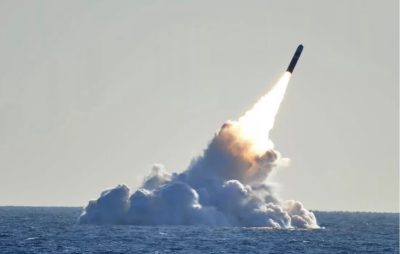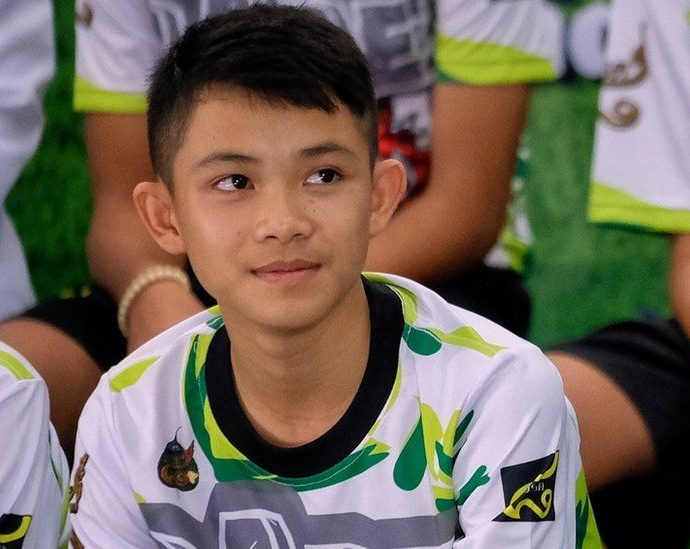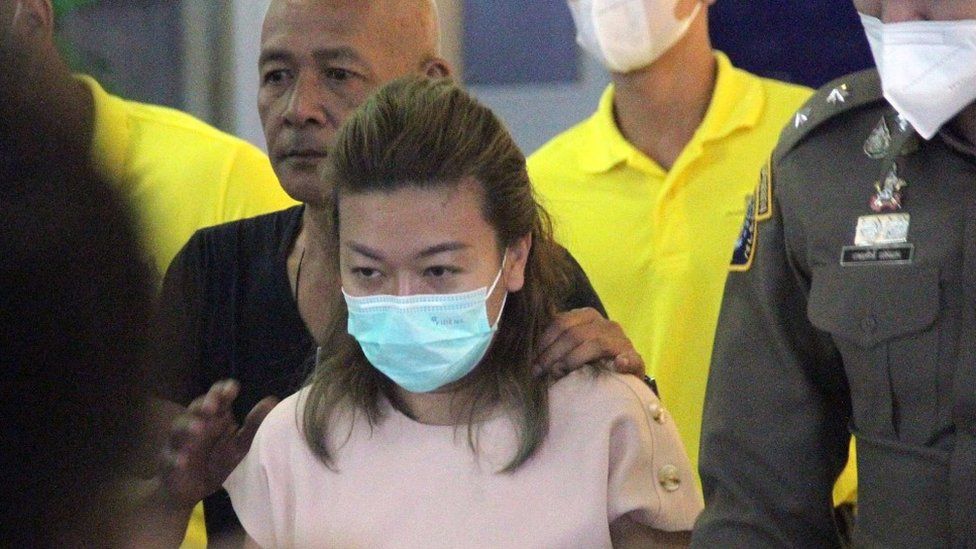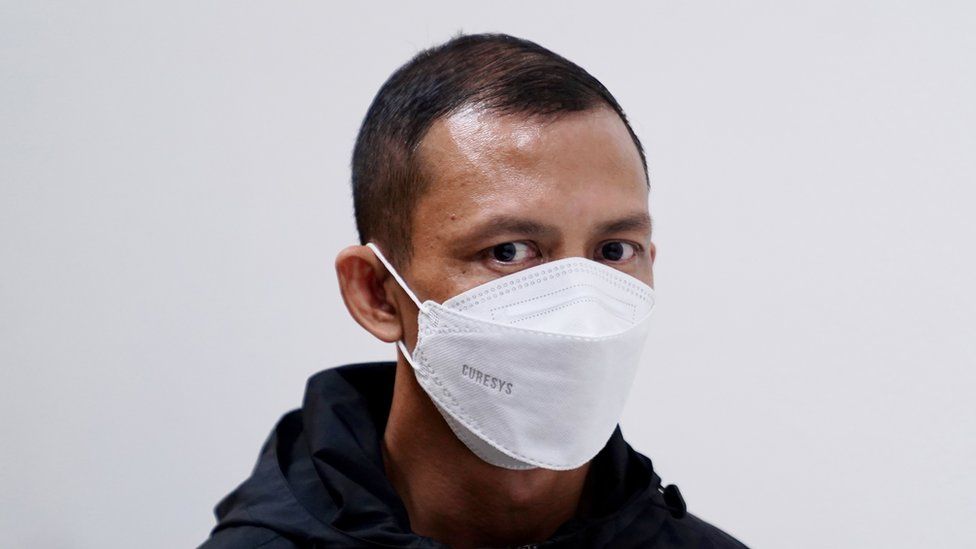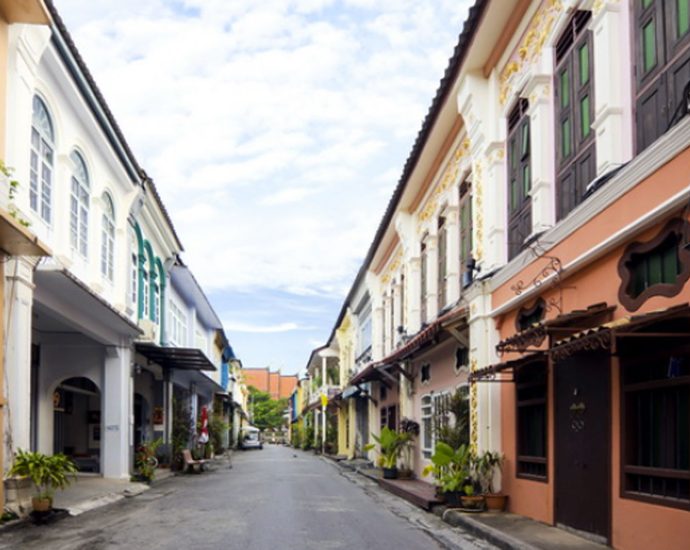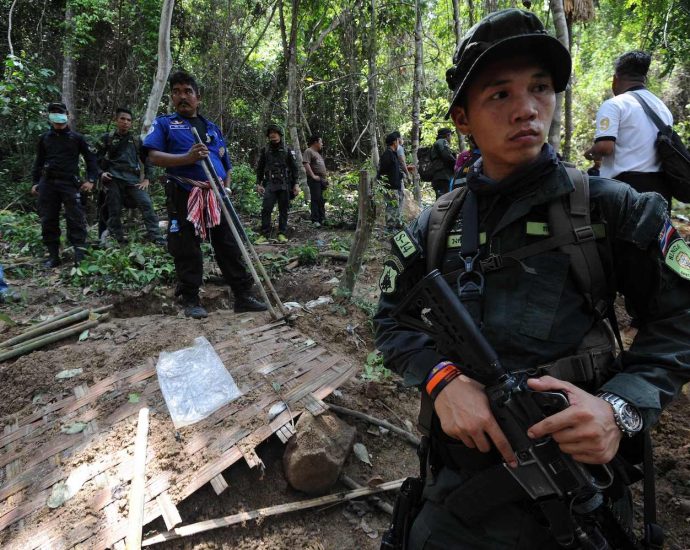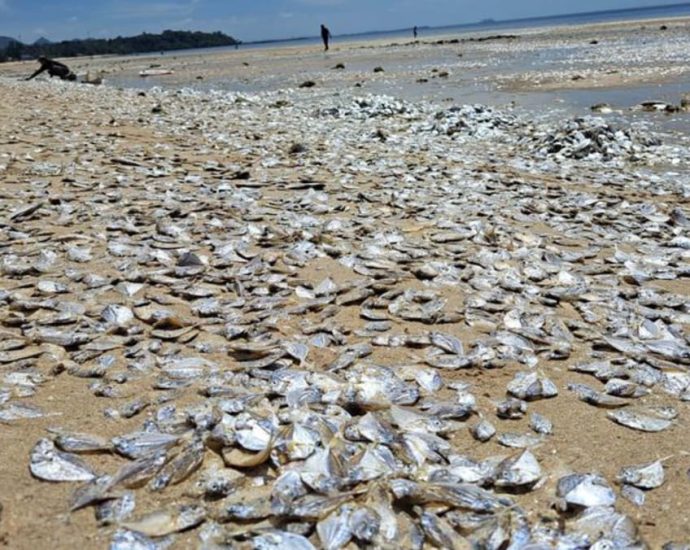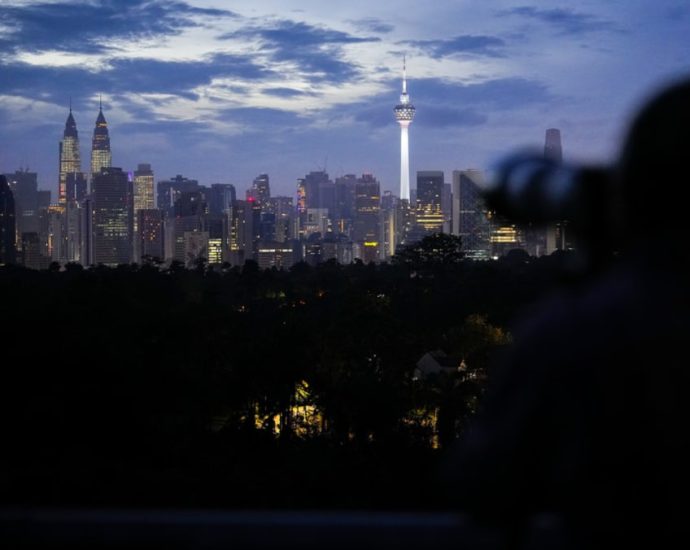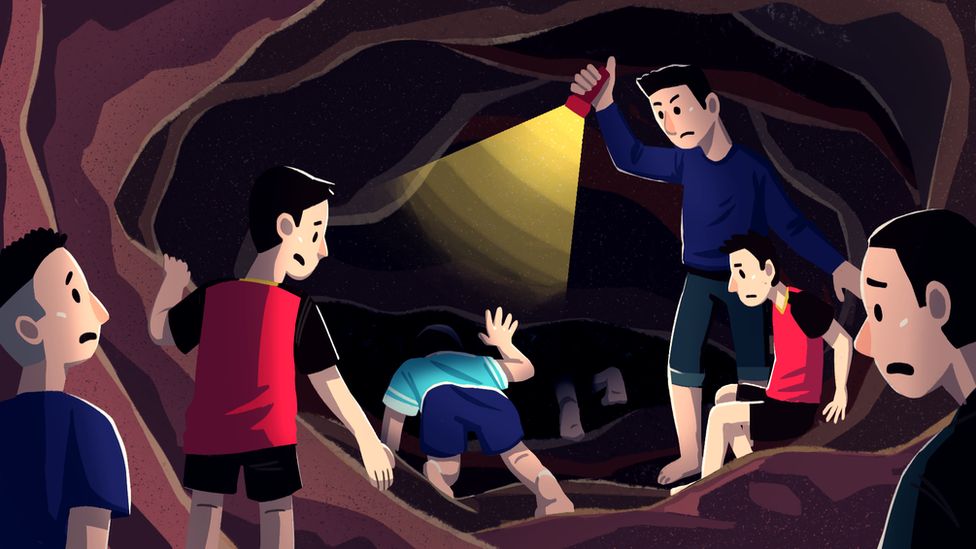S Korea inching toward long-term THAAD deployment
South Korea is edging closer to the long-term deployment of the Terminal High Altitude Area Defense (THAAD) anti-ballistic missile defense system, a controversial move that threatens to stoke tensions with China and North Korea.
This month, Jane’s reported that South Korea’s Ministry of Environment (MOE) had completed an environmental impact assessment (EIA) of the US Army’s THAAD temporarily deployed at Seongju, 215 kilometers southeast of Seoul.
“As the MOE and the MND have completed the environmental impact assessment of Seongju base in cooperation, we will closely cooperate with the US to faithfully reflect the consultation opinions and proceed with the project,” said the MND in a statement cited by Janes.
THAAD’s deployment in South Korea generated considerable controversy in 2017, with then-president Moon Jae-in accusing the MND of failing to report the system’s arrival in the country. There were also domestic complaints of a lack of an EIA assessment and backlash from locals fearing high electromagnetic wave (EMW) exposure.
Meanwhile, China complained that the system could neutralize its nuclear deterrent and responded with a series of measures to punish Seoul. Tourism dropped by about 40% and many Korean consumer goods and cultural products were boycotted inside China
Missile Defense Advocacy Alliance notes that each THAAD battery includes a launcher, interceptors, radar and fire control unit. The source mentions that the highly-mobile truck-mounted launcher can carry eight hit-to-kill interceptor missiles with 200-kilometer ranges.
It also says that the system’s Army Navy/Transportable Radar Surveillance (AN/TPY-2) radar can search, track and discriminate objects up to 1,000 kilometers away and provide tracking data to the interceptor missiles, with the fire control unit integrating all system elements.
The Institute of Security and Development policy notes that one of THAAD’s main characteristics is its transportability, which makes it easy to reposition the system.

The source mentions that feature gives THAAD flexibility to respond to changing threats, unlike the Aegis and Patriot missile systems, both of which have limited mobility.
It also says that THAAD can intercept both exo- and endo-atmospheric threats at a regional level, unlike Aegis, which can only intercept exo-atmospheric targets, and Patriot, which can only hit endo-atmospheric threats at point defense ranges.
However, THAAD also has its limitations. Asia Times noted in December 2022 that North Korea has been practicing highly-lofted trajectory missile launches to increase the chance of penetrating missile defenses such as THAAD.
Such launches result in a high terminal velocity for ballistic missiles, undermining the effectiveness of missile defenses. However, that launch significantly reduces the missile’s range, as most of its fuel is spent on reaching a high angle instead of covering great distances.
In such an attack, missile defense radars lose track of the target when the latter reaches its apex, then regain track of the hostile missile too late for interceptors to destroy. Also, as interceptor missiles fly against gravity, it is harder to catch up, correct course and hit the constantly-accelerating target at the right angle.
Adam Taylor notes in a 2017 Washington Post article that THAAD may be of limited use against North Korea as it could not take down the latter’s numerous short-range tactical ballistic missiles (SRBM) and artillery rounds that do not reach such high altitudes.
Instead, Taylor says that THAAD’s radar capabilities may be the reason behind its 2017 deployment to South Korea. He says that THAAD’s sophisticated radar could be used to track China’s missile systems, potentially giving the US an edge over China in a future conflict.
Li Bin notes in a 2016 Carnegie Endowment for Regional Peace article that THAAD’s AN/TPY-2 radar can undermine China’s nuclear deterrent by collecting essential data on Chinese nuclear warheads that the US could not acquire from other sources.
Bin mentions a missile warhead is usually cone-shaped and has a very smooth surface on the front and sides, reducing its frontal radar cross-section.
However, he says that’s not the case for the rear of missile warheads, with uneven surfaces giving that part a much larger radar cross-section.
Bin notes that the THAAD system to be deployed in South Korea could be in an exceptional position to view the back of Chinese nuclear warheads. He mentions two scenarios where THAAD can be used to gather intelligence on China’s missile arsenal.
First, Bin says that THAAD can gather intelligence on China’s missiles when the latter conducts flight tests in northeast China to develop missile defense countermeasures. He notes that intelligence gleaned by THAAD could be used to differentiate between decoys and actual warheads.
Second, Bin says that THAAD could track incoming Chinese ballistic missiles fired from Central China at a very early stage and relay their trajectory to the US national missile defense system. He mentions that would give the US more time and potential attempts to intercept an incoming Chinese nuclear warhead.
Such scenarios, Bin says, may force China to change the target points of its missile tests in the East China Sea, sparking threat perceptions in South Korea, which neither party desires. Apart from the East China Sea, China may use the South China Sea as an alternative launch area for missile tests and secondary strikes.
Asia Times reported in November 2022 that China had fielded its new JL-3 submarine-launched ballistic missile (SLBM) with a 10,000-kilometer range on its Type 094 nuclear ballistic missile submarines (SSBN), giving it the capability to hit the US from protected bastions in the South China Sea.

Previously, China’s SSBNs with the older JL-2 missile with a range of just 7,200 kilometers needed to travel into the waters west of Hawaii to launch their SLBMs, passing chokepoints such as the Miyako Strait and Bashi Channel, making them vulnerable to US and allied anti-submarine forces.
In addition, Asia Times reported in April 2023 that China is now maintaining round-the-clock SSBN patrols in the South China Sea, ensuring a second strike capability against the US.
JL-3-armed Type 094 SSBNs are now operating from Hainan to the South China Sea, showing China’s rapid improvement in logistics, command and control, and weapons to maintain a credible sea-based nuclear deterrent.
That development also indicates that China is deploying its SSBNs similar to established nuclear powers such as the US, UK, France and Russia.
Thailand: Exploding extinguisher kills student during fire drill
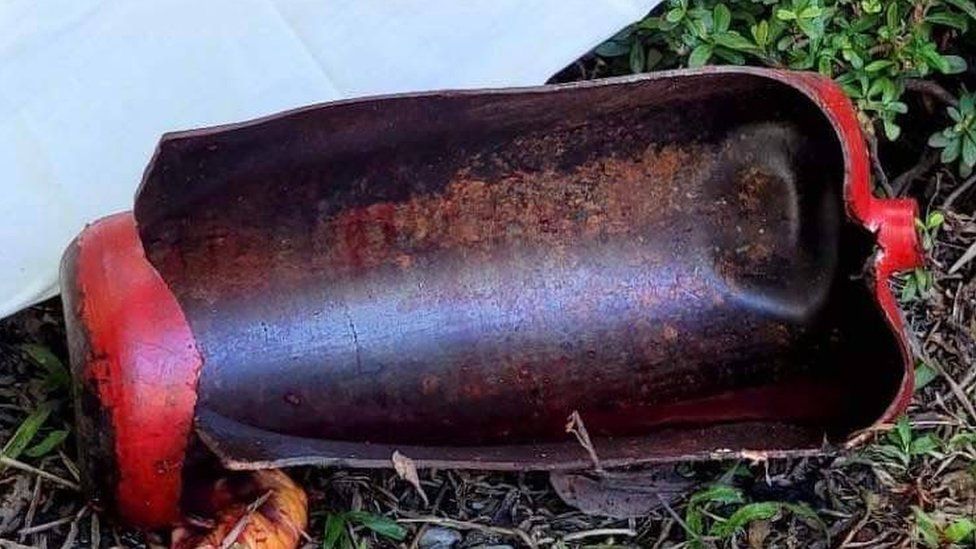 Ruamkatunyu Foundation
Ruamkatunyu FoundationA senior high school student has died after an extinguisher exploded during a fire drill at his campus in Thailand.
Twenty-one others at Rajavinit Mathayom School in Bangkok were injured in Friday’s incident, said the city’s governor. Seven were taken to hospital.
The explosion had sent the extinguisher flying towards the victim, who was about 10 metres away.
Rescuers said the extinguisher may have been defective because of sun or heat exposure.
The dead student was in his final year of school. His age has not been confirmed.
Police have been investigating the cause of Friday’s incident, cordoning off the scene which remained scattered with debris.
Officials added that the extinguishers used in the drill have all been sent to the police’s forensics division.
The exploding cannister contained carbon dioxide, according to the Ruamkatanyu Foundation, the rescue organisation on the scene.
The extinguishers are usually refilled with chemicals when empty, but “how and where they were refilled must be investigated, and safety valves must be checked”, said the city’s police chief.
The school is located in the Dusit district, alongside many government offices.
Ministry of Education officials have also been sent to the school to determine what happened, permanent secretary Atthaphon Sangkhawasee said.
He expressed condolences to the relatives of the dead student, adding that the ministry would assist and compensate those affected, according to The Nation.
Related Topics
-
-
15 February
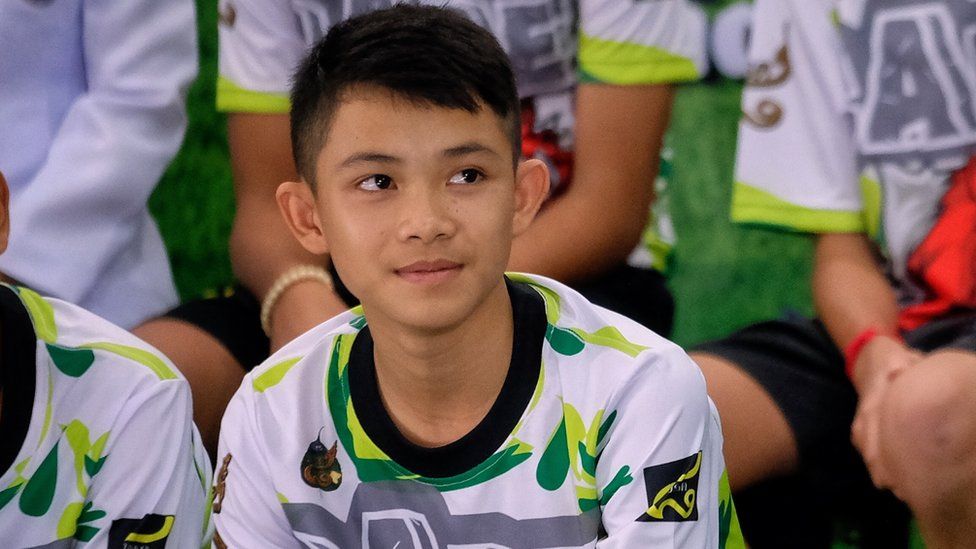
-
-
-
16 February
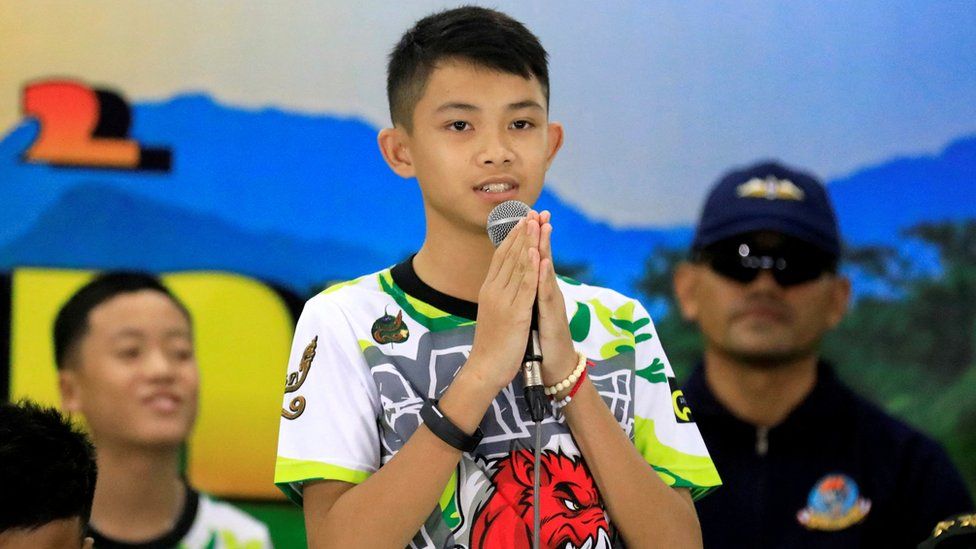
-
Soi Romanee named one of world’s most beautiful streets

Soi Romanee, an old narrow side-street in Thailand’s southern island resort province of Phuket, has been ranked the world’s 19th most beautiful street by Seasia.Stats, a news website from Southeast Asia.
The website posted the rankings of “The World’s 20 Most Beautiful Streets” on its Facebook page on June 11.
Soi Romanee is renowned for its old colonial-style buildings with Sino-Portuguese architecture, creatively adorned with vibrant colours, said acting government spokesman Anucha Burapachaisri said on Friday, adding that Prime Minister Prayut Chan-o-cha is very pleased with the recognition.
Located in the historical centre of Phuket Old Town in Muang district, Soi Romanee is a short street with a long and colourful history. Today, it is home to souvenir shops, elegant ice cream parlours and small but posh guesthouses.
In the past, this side-street served as the red-light district of Phuket, where ones would find brothels, opium dens, gambling houses and other similar entertainment venues, many of which now stand as ruins.
Numerous structures have been renovated and transformed into coffee shops, souvenir shops and guesthouses, while some still serve as residences, making it a vibrant and enjoyable place to visit.
The top five streets on the list are as follows: 1. Symi Harbour of Livadia, Greece; 2. Acorn Street of Boston, the United States; 3. Bo-Kaap of Cape Town, South Africa; 4. Callejoin El Asri of Chefchaouen, Morocco; and 5. Rua Luis de Camoes of Agueda, Portugal.
[embedded content]
Malaysian court charges 4 Thais with human trafficking
First-ever extradition of Thai criminal suspects is linked to 2015 find of mass graves near border

KUALA LUMPUR: A Malaysian court on Friday charged four Thai nationals with human trafficking in connection with the discovery eight years ago of mass graves near the country’s border with Thailand.
More than 100 bodies were discovered buried deep in the jungle in 2015, triggering an investigation.
The four men, aged between 30 and 58, were charged under Malaysia’s anti-trafficking in persons and anti-smuggling of migrants law.
The men are alleged to have been involved in the trafficking between 2013 and 2015, and face up to 15 years in jail if found guilty, according to court documents.
After being extradited to Malaysia on Thursday, the suspects will be held in a prison in the northern town of Kangar ahead of their next court appearance on July 25.
The men, wearing white T-shirts and chained together, were brought to a court in Kangar, which borders Thailand, near where the graves and trafficking camps were found.
The suspects were among 10 Thai nationals that Malaysia had sought for since 2017 as part of an investigation into the border camps.
“This is the first time in Thai history that Thai individuals have been extradited to be punished abroad,” Pol Lt Gen Surachate Hakparn, the deputy national police chief, said at a briefing in Bangkok on Friday.
The region, known for its porous border, has long been a gateway for persecuted Rohingya Muslims fleeing violence in their native Myanmar and economic migrants from Bangladesh.
Smugglers have in previous years brought tens of thousands of Rohingya on a perilous journey over land and sea to Malaysia, a relatively affluent and safe Muslim-majority country.
Malaysia depends heavily on cheap foreign workers from Indonesia, Bangladesh and Myanmar for its construction, plantation and services sectors.
A 2019 report by Malaysian human rights commissioners and a rights group said a human smuggling syndicate operated in the area from 2012 to 2015.
Migrants were reportedly held in inhumane jungle camps where they faced physical violence and were often denied adequate access to food and water.
The Criminal Court in Thailand convicted 62 people, including an army general, police officers and provincial officials, in 2017 at the end of Thailand’s biggest ever human-trafficking trial.
Climate change may have stimulated plankton bloom behind Thai mass fish die-off: Expert
BANGKOK: Climate change might have stimulated a plankton bloom that caused thousands of dead fish to wash up along a 3 to 4km stretch of beach in Thailand’s southern Chumphon province, an expert said. Thon Thamrongnawasawat, deputy dean of the Faculty of Fisheries at Kasetsart University, attributed the fish deathsContinue Reading
AUKUS part of strategy to preserve US regional dominance

The AUKUS agreement reached in September 2021 has left Australia more deeply entangled with US strategic priorities and war preparations than ever before.
AUKUS reflects the prevalent view within the US security establishment that China’s rise poses a major threat to America’s regional and global dominance – a view, as it happens, strongly supported by Australia’s security elite.
Australian governments, under the previous conservative coalition and now under Labor, have repeatedly pointed to China’s misdeeds.
In a major address in April, Foreign Minister Penny Wong took issue with China’s rapidly rising defense budget, its militarization of disputed islands in the South China Sea, its ballistic missiles falling in Japan’s exclusive economic zone (EEZ), and its military drills and blockades around Taiwan.
By contrast, Australia has steadfastly refrained from criticizing the United States for any of its provocative actions, not least Nancy Pelosi’s much-publicized visit to Taiwan or President Joe Biden’s often-stated position that US forces would intervene should Taiwan come under threat.
Meanwhile, Australian mainstream media have dutifully reported US and Australian portrayals of the “China threat,” and become increasingly vociferous contributors to the anti-China frenzy.
The rhetoric has been faithfully supported by action. The last few years have seen the steady expansion of joint US-Australian military exercises, notably Talisman Sabre and Exercise Pacific Vanguard.
In addition, the United States now controls or has extensive access to an ever larger array of military assets on Australian soil, including the high-technology bases cluster along the length of North West Cape in Western Australia, the port and air base of Darwin, and the Tindal air base.
To this must be added the large and still growing Pine Gap facility likely to play a key role in any US conventional and nuclear operations from Africa to the Pacific.
Simply put, once China’s rise came to be seen by the US security establishment as inimical to its interests, Australian governments have been quick to follow suit.
Unsurprisingly, the Australian government secured the services of two retired US admirals and three former US Navy officials as highly paid consultants to advise it during the negotiations to acquire top-secret nuclear-submarine technology. This advice no doubt contributed to the cancellation of the French submarine contract and the establishment of AUKUS.
Motives for militarism
All of which prompts the question: What lies behind Australia’s subservience to US militarism? Much of it has to do with the fact that Australia’s policymakers have traditionally felt most comfortable when connected to the anglophone world and at best uneasy when dealing with the East.
One other pull factor helps explain the addiction to imperial power. Australia’s political, bureaucratic, military and intelligence elites see themselves as having unique access to an exclusive and powerful club that confers status and privileges – once the British club, now the American club.
They may have reluctantly accepted the demise of the former, but are in no mood to accept the slow but steady decline of the latter.
The first tangible commitment under the highly secretive AUKUS arrangements is the decision to provide Australia with eight nuclear-powered submarines (SSNs) at an estimated cost of A$368 billion (US$246 billion).
Costly deal
The plan, however, is fraught with uncertainty and danger. Will the submarines be delivered on time? Will the cost involved greatly exceed the current estimate?
Added to this are the complex technological and security problems that will inevitably arise.
First, to build nuclear-powered submarines, Australia will need to be supplied not just with the technology for the nuclear reactors, but also with the nuclear fuel. Transport of such fuels over long distances raises the prospect of diversion to a third party, widely considered a major nuclear-proliferation risk.
Second, the reactors used by the submarines will generate a significant amount of nuclear waste, which will have to be returned to the supplying country or stored in Australia. Either way, the country will face the highly contentious problem of nuclear waste disposal.
Third, there is always the possibility of a nuclear reactor being breached, or at least of a leakage of nuclear materials.
The AUKUS deal poses troubling questions that remain unanswered. If answers are ever offered, they are likely to prove less than reassuring.
In short, Australia has saddled itself with a vast military project of unknown cost and duration and dubious effectiveness. It will contribute to an ever-increasing defense budget that will divert scarce resources from urgent social and economic priorities.
Importantly, it will fan the flames of resentment in China not just among the Chinese leadership, but among a wide cross-section of Chinese society. Beijing has repeatedly argued that the AUKUS project will fuel an arms race and raise the level of mutual mistrust. It will certainly reinforce China’s perception that it is surrounded by a hostile coalition.
Regional responses
While the reactions of other countries have been generally more subdued, there is no denying the widespread unease AUKUS has already provoked. Some governments, it is true, have accepted the security partnership, but few have done so with undiluted enthusiasm.
Singapore has indicated support in principle for AUKUS insofar as it helps to balance China’s assertiveness and contributes to regional peace and stability. The Philippines, for its part, has gone so far as to characterize AUKUS as “essential to our national development and to the security of the region.”
Japan too has generally welcomed AUKUS, which it sees as “strengthening engagement [of those three countries] in the Indo-Pacific region.”
There have even been indications that Japan would cooperate closely with AUKUS. Some have even contemplated the possibility that Japan might join AUKUS at some future date. It is worth noting, however, that Tokyo has studiously refrained from open support of the submarines deal because the acquisition of nuclear subs remains a highly contentious issue in the context of both Japanese politics and public opinion.
South Korea too has been guarded in its comments, expressing support for AUKUS insofar as it contributes to regional peace and security, but has said little about the nuclear-submarine program.
The response of other countries in the Association of Southeast Asian Nations has ranged from unease to open criticism.
Vietnam, notwithstanding its territorial dispute with China, has said little about AUKUS, confining itself to support for the peaceful use of nuclear energy. Thailand has gone further and expressed concern that AUKUS could fuel a regional arms race.
Indonesia has been especially critical. It sees AUKUS as committed to the forward projection of military power that could well provoke China into adopting an even more assertive stance. In Indonesia’s view, Australia’s acquisition of nuclear-powered submarines could “set a dangerous precedent” for other countries with similar ambitions “to follow suit.”
Malaysia too has expressed deep misgivings.
While acknowledging the right of the countries concerned to upgrade their defense capabilities, it has more than once made it clear that it expects all countries, including the three AUKUS partners, to respect and comply with Malaysia’s requirements with regard to nuclear-powered submarines, as stated in the Law of the Sea Convention, the Southeast Asia Nuclear Weapons Free Zone, and the ASEAN Declaration on the Zone of Peace, Freedom and Neutrality (ZOPFAN).
India, for its part, has avoided public comment on the issue. While some commentators have suggested that AUKUS could help check “China’s aggression,” many others fear the prospect of an even more assertive China. A growing Chinese naval presence in the Indian Ocean cannot but pose a challenge to Indian interests.
It remains to say a word about the attitudes of Pacific Island nations. While some have indicated varying degrees of support, notably Fiji, several others have been sharply critical. Solomons Prime Minister Manasseh Sogavare lambasted the Australian government’s lack of consultation on the AUKUS deal.
A communiqué issued by four former prime ministers (Marshall Islands, Palau, Kiribati and Tuvalu) described “the staggering A$368 billion” earmarked for the AUKUS submarine deal as an affront to the region, suggesting that these resources could be better spent combating climate change.
Current leaders in Tuvalu, the Cook Islands and Kiribati, have also pointed to the likelihood that the AUKUS arrangements will make for an increasingly militarized and unstable region. These reactions are hardly surprising. A zone that has endured the catastrophic damage of nuclear testing is unlikely to welcome the intrusion of nuclear-powered submarines into its seas.
US military presence
These varied responses are themselves indicative of the deep divisions that have re-emerged in the Asia-Pacific region. The containment policy pursued by the United States during the Cold War years is back with a vengeance, except that the stakes are now much higher and containment is euphemistically described as “strategic competition.”
Recent years have seen frenetic efforts by the United States to construct an overwhelming military presence in both the Indian and Pacific Oceans.
AUKUS is but one prong in a multi-pronged “Indo-Pacific” strategy based on the unrelenting modernization and expansion of America’s military alliances with Japan, South Korea, the Philippines, Thailand and Australia, and its extensive security arrangements with Taiwan, Singapore, New Zealand and Pakistan.
Bilateral and multilateral arrangements between the US and these countries involve large and increasingly frequent joint military exercises, vastly expanded programs in maritime surveillance, cybersecurity, construction of new military facilities, and access to a growing number of military bases.
All of this is unfolding in the context of greater interoperability between the US and allied forces, rapidly growing military modernization investments, and the acquisition of new military platforms, including radar systems, drones, military transport aircraft and coastal and air defense systems, including multi-role fighter aircraft and an array of precision-guided air-to-surface and other missile systems.
The militarization of the Asia-Pacific region, which AUKUS will greatly accelerate, has seen military spending in this region rise to US$575 billion in 2022. During 2018-2022, Asia and Oceania accounted for 41% of global arms imports. The largest exporter by far was the United States and the largest importers were US allies.
Arms imports by East Asian states increased by 21% between 2013-17 and 2018-22, with the largest increases recorded by US allies: South Korea (+61%) Japan (+171), and Australia (+23%). Here lies one of the key drivers of the globalization of the North Atlantic Treaty Organization.
Unsurprisingly, US-based weapon manufacturers have recorded a massive increase in sales from $103.4 billion in 2021 to $153.7 billion in 2022. For them the Ukraine war and rising Sino-US tensions have been a godsend, except that God had little to do with it.
The main drivers of these trends have been the principal beneficiaries, which include weapons manufacturers, armed private security contractors, a wide array of logistics and reconstruction firms and their combined ability to shape public opinion and policymaking elites through their close connections with mainstream media and their funding of policy think-tanks.
In this sense the AUKUS deal is emblematic of a deeply embedded militarization of economy and society that risks shifting the Asia-Pacific region from competition to confrontation, and eventually war.
No quick fixes to the despair in Malaysian stock and currency markets
KUALA LUMPUR: The bumpy ride in Malaysia’s financial markets is about to get bumpier as expectations for an uptick in foreign and domestic investor sentiment following the appointment of Mr Anwar Ibrahim as premier in November last year have dissipated. The road to economic recovery has been undermined by aContinue Reading
Thai cave rescue: Official hailed as hero of cave rescue dies
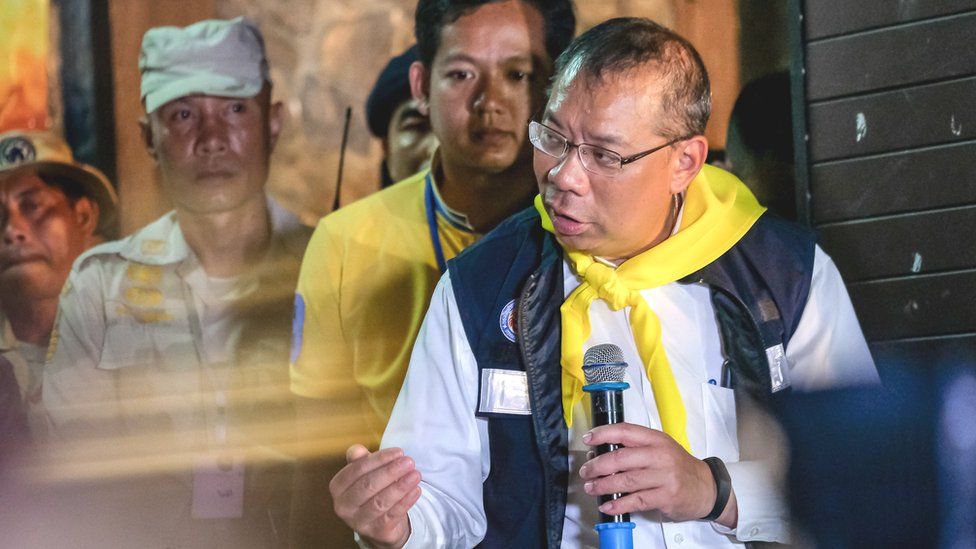 Empics
EmpicsA Thai official who oversaw the dramatic rescue of 12 boys and their football coach from a flooded cave in 2018 has died of cancer.
Narongsak Osottanakorn died on Wednesday in a week that marks the fifth anniversary of the cave rescue. He was 58.
He is beloved in Thailand as the “Wild Boar Governor”, named after the football team he helped save.
Mr Narongsak is survived by his wife and two daughters.
HIs death comes just four months after the Wild Boars’ 17-year-old captain, Duangphet Phromthep, died in the UK. Thai media reported that he had succumbed to a head injury.
Mr Narongsak was the governor of the Chiang Rai province in northern Thailand where the the boys and their coach were trapped deep inside the Tham Luang cave for 18 days.
During that time Mr Narongsak coordinated the rescue mission, involving teams from several countries, including the UK, US and China. He was often seen near the site supervising what was happening, and held daily press briefings.
He drew widespread praise in Thailand for his work in the cave rescue – a mission that, in his words, had “united humanity as a whole”.
“With over 10,000 people involved, even if one function was missing, we would not have been able to do it,” he said in New York in 2018 after receiving an award from the non-profit, Asia Society.
When news of Mr Narongsak’s death broke, two of the cave survivors – one of whom was the coach – stopped football practice to offer prayers. “Thank you for saving the lives of all 13 of us. May your soul rest in a better place,” the teen said in a video later shared on Facebook.
There were also tributes on Twitter. One user shared an illustration showing Mr Narongsak as an elephant with eyeglasses, leading a pack of wild boars out of a cave, while tossing a football with his trunk.
“We will always remember his goodness forever,” another Twitter user wrote, while a third one praised him for displaying “leadership in a critical moment”.
Mr Narongsak was last seen in public at his daughter’s wedding, six days before his death. Thai media published pictures showing the frail governor, masked and in a wheelchair, as he took part in the ceremony. He had been battling cancer for five years.
His funeral is being held at a temple in Bangkok, and the Thai royal family is reported to have sent wreaths and holy water to perform the bathing rites. Some of the boys from the Wild Boars will take part in a Buddhist ritual in his honour, Thai media reported.

Born in 1965, Mr Narongsak was a veteran bureaucrat who had served multiple roles in public service, including a stint in the Ministry of Interior.
He was appointed governor of Chiang Rai in 2017, a post he held for 15 months. The province in northern Thailand is known for its verdant trails.
He was due to be transferred to Phayao, a smaller province, when the football team became trapped in the cave. But the government postponed his move so he could oversee the rescue mission.
He had a master’s degree in Geodetic Science, the study of properly measuring the size and shape of the earth.
When he died, Mr Narongsak had been serving as governor of Pathum Thani province since 2021. He was reportedly asked to run for governor of Bangkok, but declined for health reasons.
Related Topics
-
-
15 February

-
-
-
10 July 2018

-
Malaysia to take legal action against Meta for failing to remove âundesirable contentâ from Facebook
KUALA LUMPUR: Malaysia’s Communications and Multimedia Commission (MCMC) on Friday (Jun 23) announced that it will take legal action against Facebook’s parent company Meta Platforms Inc for failing to remove “undesirable content” from the platform. “As there is no sufficient cooperation from Meta, MCMC has no option but to takeContinue Reading
Bridge Data Centres Expand Footprint At MRANTI Park
The expansion will add 48 MW to the IT power capacity
In total, the BDC’s MY03 will provide a total IT power capacity of 64MW
Asia Pacific data centre solutions provider, Bridge Data Centres (BDC), has announced plans to expand its hyperscale data centre campus, MY03, located at MRANTI Park, Kuala Lumpur. This…Continue Reading

